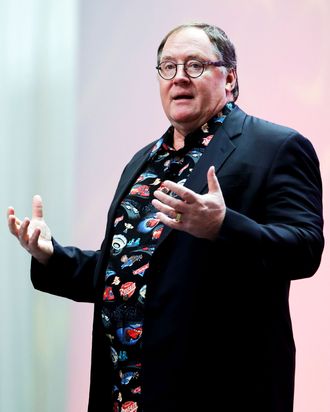
Before his professional downfall last year, John Lasseter had ascended, Icarus-like, to the highest heights of the animation industry. The Disney veteran was at the top of the Mouse House’s executive chain of command, the chief creative officer of not only Walt Disney Animation Studios and Pixar but also Disneytoon Studios, as well as principal creative advisor for Walt Disney Imagineering. The films Lasseter wrote, produced, or directed have combined to gross more than $20.8 billion worldwide, making the CGI pioneer and two-time Academy Award winner one of the most successful filmmakers in Hollywood history. The animated features he directed himself — including 1995’s Toy Story and Cars, along with their blockbuster sequels — set new standards for quality and characterization within the industry while crystalizing the Pixar brand.
Then in 2017, multiple women stepped forward to detail Lasseter’s pattern of making unwanted sexual advances toward female employees — which allegedly involved serial hugging, “grabbing, kissing, making comments about physical attributes,” and encouraging a “sexist and misogynistic culture” at the company. According to the women, all of the aforementioned behavior was covered up by Disney executives; he was reportedly assigned “minders” who were responsible for “reigning in his impulses.” In turn, the chief creative admitted to unspecified “missteps” in a memo to staff and took a leave of absence. In June 2018, he officially resigned, leaving a power vacuum within the animation industry’s most ambitious, prolific, and successful studio divisions.
The former Disney-Pixar chief’s extended “sabbatical” didn’t last long. Earlier this year, he accepted a new position as head of Skydance Animation, a Paramount-based offshoot of David Ellison’s Skydance Media, the production company behind such franchises as Mission: Impossible and Terminator. The assignment has been viewed by many as a professional step down; Skydance Animation has not yet released an animated feature nor announced plans for what its debut animated offering will be. Time’s Up issued a statement soon after admonishing Skydance for hiring Lasseter. The company declined to respond to Vulture’s interview requests, though they addressed the allegations against Lasseter in their initial announcement.
Disney, meanwhile, moved on, splitting Lasseter’s old responsibilities among new executives, with Academy Award–winning Frozen co-director Jennifer Lee assuming the role of chief creative officer at Walt Disney Animation Studios and Pete Docter, the two time Oscar-winning director of Up and Monsters, Inc., stepping in as chief creative at Pixar. Today, both Pixar and Walt Disney Animation find themselves in a transitional moment, despite the fact that the June release of Pixar’s Toy Story 4 was greeted with more than $1 billion in global ticket sales and the impending release of Disney Studios’ Frozen 2 next week is widely expected to trigger the same paroxysm of moviegoing that led the first Frozen to take in $1.276 billion worldwide. To hear it from their respective presidents, neither studio division is operating the same as it was under Lasseter — which they both describe as a positive thing.
Disney’s animated divisions have long functioned as boys’ clubs, where a handful of powerhouse white male creators ruled the roost with a sense of historical entitlement while women, and to an even more minimal extent animators of color, toiled in relative obscurity. But now, with the implementation of Pixar’s SparkShorts series for Disney+ — a talent incubator within which promising young animators are given limited budgets and six-month windows to create short-form movies for the platform — that perception is changing. Disney’s overarching new goal seems to be creating a deeper bench of emerging talent and a multiplicity of styles, so that if one aging animator leaves, the brand isn’t thrust into crisis. Both presidents agree evolution is in the air at the intersection of Mickey Avenue and Dopey Drive.
According to Pixar president Jim Morris, the studio was on the cusp of change even before Lasseter’s exit. Executives were aware of the advancing age of its dream team of key (male) filmmakers — Docter, Andrew Stanton (Wall-E), Lee Unkrich (Coco, Toy Story 3), and Brad Bird (Incredibles 2, Ratatouille). “Those guys are all middle-aged or older now and they’re not going to be the filmmakers ten years from now. They’re not going to necessarily be the ones that have their finger on the zeitgeist,” Morris tells Vulture. “And we knew that. Animated films come from people of their time, if that makes any sense. Just as John was, and Andrew, Pete, and Lee were when they made their first films.”
Since Lasseter’s departure, Morris says that women have come to comprise half of Pixar’s creative-approval team, and that the company is making a concerted push to diversify its ranks of filmmakers. “We’ve been leaning into that pretty heavily over the last couple of years since John’s been gone — just looking at those different voices and trying to foster them and grow and figure out what’s next and how to make it work,” he says. “So I would say, yes, the company’s quite a bit different now. Pete’s been very supportive of letting filmmakers basically have the keys to the car. We will judge how they drive it but we won’t tell them how to drive it.”
Walt Disney Animation Studios president Clark Spencer has been in the Disney fold for 30 years, producing such films as Ralph Breaks the Internet and Zootopia in addition to serving as a studio executive, and is no stranger to regime change. When I ask him how Disney Studios has changed since the Lasseter era — and whether the studio division has learned anything from the scuttlebutt surrounding the former chief’s departure — Spencer points toward the most obvious: the gender of WDAS’s chief executive.
He is unreserved in his praise for Jennifer Lee, who wrote such films as 2012’s Wreck-It Ralph and A Wrinkle in Time, in addition to becoming the first woman to direct a Disney animated feature (and co-create one of the most popular family films of all time in the process) with Frozen. “She’s done an amazing job at bringing a new point of view,” Spencer says. “There are moments when it is important to have some new points of view come in. You have to evolve. When she came in, she brought her experience in filmmaking, her experience in storytelling because she has a background as a writer, right? And she brings a unique point of view being a woman and somebody who really believes deeply in the world of Disney animation. I see that as the next chapter.”
Beyond its shift toward emerging talent, the company has begun looking to the future in other ways. It’s perhaps unsurprising that Disney Animation Studios aims to become a pioneer within the animated space’s last untamed frontier: virtual reality. In July 2018, the company rolled out Cycles, its first VR short, which made the rounds at the New York and Sundance Film Festivals. Earlier this month, at the Hollywood premiere of Frozen 2, WDAN debuted Myth: A Frozen Tale, an immersive virtual reality experience that thematically dovetails with the Elsa-fronted fantasy.
“No one’s cracked how you tell a full story in VR or all the technical aspects to make it become incredibly immersive,” Spencer says. “But Disney has been doing a lot in that territory, expanding what you can do storytelling-wise and emotionally in VR. That’s a super, super exciting world. It’s not clear to me exactly where that future goes. But we’re starting to break down those walls, to take it beyond what people have experienced so far.”
More From This Series
- Every Studio Ghibli Film, Ranked
- The Hardest Thing I Ever Animated
- How Don Hertzfeldt Survives as an Indie Animator





